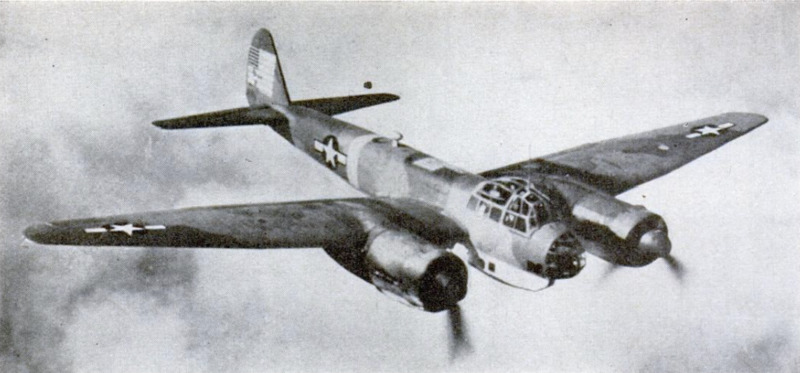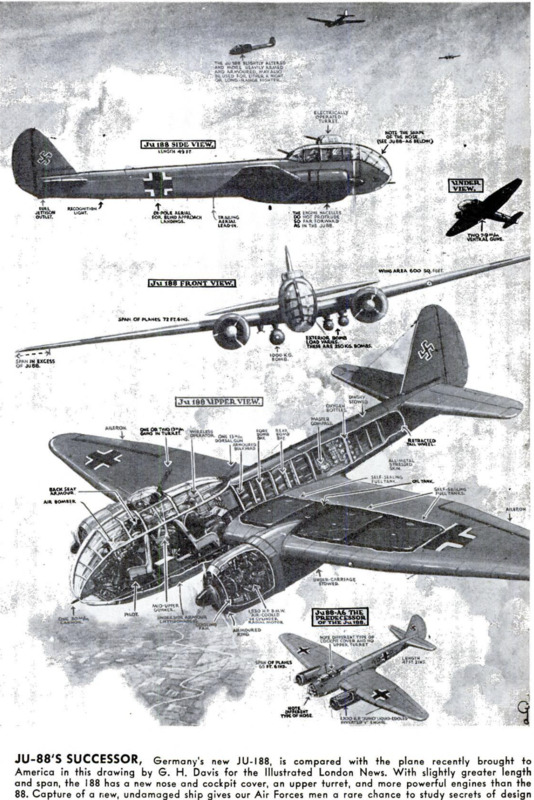Secrets of the german Junkers JU-88
Contenuto
-
Titolo
-
Secrets of the german Junkers JU-88
-
Article Title and/or Image Caption
-
Title: Nazi plane yields secrets
-
Subtitle: Here's one german bomber that flew to America but it took a couple of USAAF men to get it there
-
extracted text
-
PERHAPS the most closely guarded air-
craft at Wright Field, Dayton, Ohio, is
Baksheesh, the first German combat plane
to fly the Atlantic—luckily, with an Ameri-
can crew.
This German Junkers JU-88 high-altitude
bomber was deliberately flown into the hands
of the Allied Command by a young Nazi
pilot fed up with the whole business. The
two arrived at a field on the island of Cyprus
last September, to the delighted bewilder-
ment of all concerned, except the pilot.
Almost brand new, with less than 50
hours’ flying logged, the plane was test-
flown by the British and then, through
diplomatic arrangements, turned over to the
AATF for evaluation. Marked with American
flags and insignia, it was flown to Wright |
Field by Maj. Warner E. Newby and Lieut.
G. W. Cook, AAF, giving some of our
aircraft spotters a thrill on the way.
Baksheesh, Persian for “something for
nothing,” proved to be a fighting man's air-
plane; rough-and-ready, tough, and (to
quote the Major) the “heaviest and most
vicious airplane I had ever flown.” It also
had, still to quote the Major, “more damned
gadgets than any plane I had ever seen.” |
The JU-88 was minutely inspected and
studied before leaving Africa and fitted with
auxiliary gas tanks from a Lockheed Light--
ning. In testing the emergency droppinggear for the tanks, Lieutenant Cook re-
ceived shrapnel wounds in his back. He was
under the tank during the testing, and the
Bombenbefreiung (bomb-release) button ac-
cidentally set off explosive charges in the
wing, which blew the tank, shackle, and
bomb rack to which it was attached right
off the wing.
This incident led to another thorough in-
spection of the craft for other “tricky”
devices. It was lucky this was done, for
another button was found wired to set off
explosive charges in the tail and completely
demolish it. This explains why so many
Nazi planes have been captured with their
tails missing but otherwise undamaged.
Flying back to the United States in hops
of from 900 to nearly 1500 miles at an
average speed of 240 mph. the Junkers
clicked off the 12,000 miles in 5% days.
The aircraft gave little trouble, considering
the nonregulation fuel and equipment that
had to be used and the myriads of unknown
buttons and unfamiliar gadgets the two men
had to work with. Their opinion of the air-
craft is high; it flew well, the radio compass
was very good, and the automatic pilot and
navigational equipment were efficient. To
these, and to the skill of Major Newby and
Lieutenant Cook, goes the credit for the
first flight of a German combat plane across
the Atlantic.
-
Autore secondario
-
G. H. Davis (illustrator)
-
Lingua
-
eng
-
Data di rilascio
-
1944-03
-
pagine
-
78-79
-
Diritti
-
Public Domain (Google digitized)
-
Archived by
-
Lorenzo Chinellato
-
Marco Bortolami (editor)



